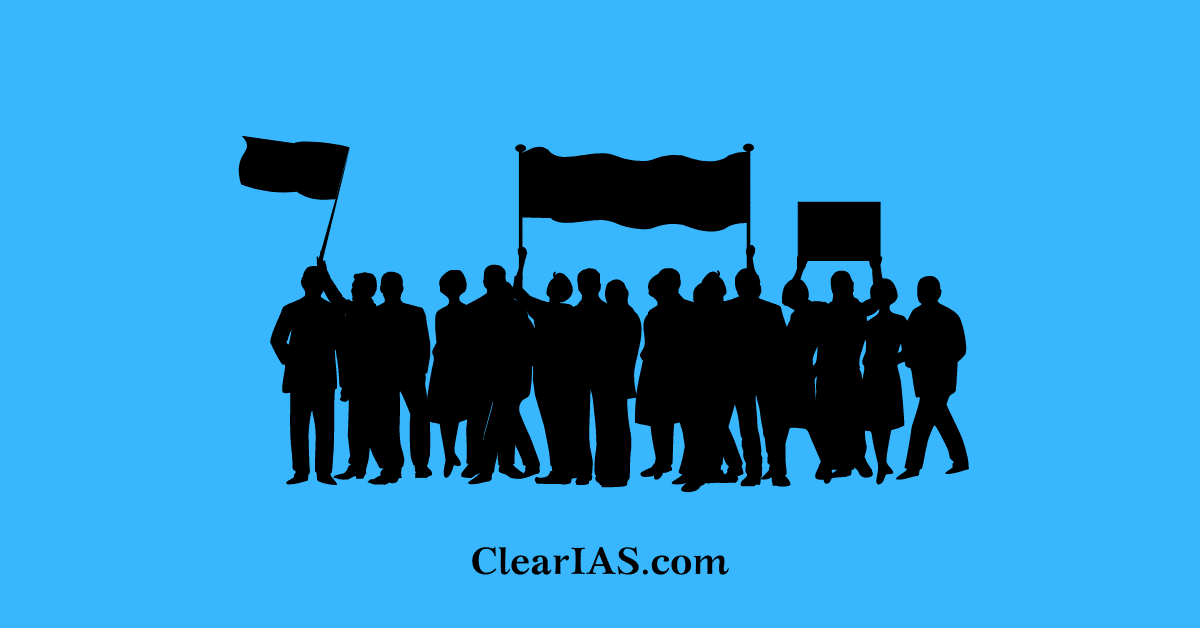 Pressure Groups and formal/informal associations and their role in the Polity is an important topic mentioned in UPSC Civil Services Mains General Studies Paper 2 (GS2) syllabus. Aspirants preparing for Prelims are also advised to have a look at this topic.
Pressure Groups and formal/informal associations and their role in the Polity is an important topic mentioned in UPSC Civil Services Mains General Studies Paper 2 (GS2) syllabus. Aspirants preparing for Prelims are also advised to have a look at this topic.
ClearIAS.com is glad to inform our community that this article was contributed to us by Vineet Dubey from Madya Pradesh under our * Write Articles – Win Prizes! * contest. Though our editorial team has added a few related/additional information regarding Pressure Groups in the same article to cover the topic in a single article, the lion’s share came from Vineet. Vineet is also the winner under Best Entry for the month of April. Congrats to him!
Update from ClearIAS.com
If our new subscribers are not aware, ClearIAS.com for the last few months has been running a programme under the name “Write Articles – Win Prizes!“, where our readers can submit their articles as guest contributors.
The main motive is to encourage aspirants to work more and polish their writing skills to suit the UPSC requirements. The articles should be relevant for UPSC Civil Services Prelims, Mains, or Interview and only those articles meeting our quality guidelines will be published. Rules and regulations are mentioned in detail in the highlighted link. Rush your entries for May and June! All the best.
Pressure Groups and Their Role in the Polity
A pressure group is a group of people who are organized actively for promoting or defending their common interest. The term ‘pressure group’ is used as the group attempts to bring a change in public policy by exerting pressure on the government.
Pressure Groups are also known as Interest Groups or Vested Groups. There is a large no. of formal /informal groups that influence the polity of any country, right from the formation of government itself to day-to-day governance issues. Superficially all the formal & informal associations collectively could be termed ‘Interest Groups’ as all of them have certain vested interests related to the general governance of the country.
Interest groups are numerous and of many kinds but whenever they become active in achieving their interests through their attempts to influence public affairs at the administrative or legislative level they are termed Pressure groups.
Pressure groups are sometimes referred to as the ‘Anonymous Empire’ & ‘legislation behind legislature’ due to their strong presence and influence in the polity. One of the characteristic features of any pressure group is that they try to manipulate governmental affairs without any intention to have any direct control over it which is one thing that differentiates it from a political party.
Techniques Used by Pressure Groups:
- Electioneering: Placing in public office persons who favor their interests.
- Lobbying: Persuading public officers to adopt and enforce policies of their interest.
- Propagandizing: Influencing the public opinion.
Pressure groups may sometimes make use of media to disperse their views in public and win support. They may publish statistics in favor of their claims. However, sometimes they may even resort to illegitimate and illegal methods like strikes, violence, or even bribes.
Read: Political Party system
Pressure Groups in India

- After independence, a single political party was dominant over the government for a long time and the role of pressure groups was limited & perceived negatively but today their role are taken to be constructive and democratic.
- Conventional Pressure Groups (PGs) based on caste, community, religion-based & regional groupings play a decisive role in Indian polity.
- Most political parties do not have any clear nationalist ideology & they remain backed by certain groups especially religious and minority communities.
- There is also news about the presence of foreign lobbies in parliament (e.g. lobbying by US companies in case of FDI). Institutional PGs like FICCI, CII, etc. also influence policy decisions.
- PGs remain more concerned with administration rather than policy decisions, much of their efforts are directed toward influencing general administration.
- PGs make use of party platforms to put forward their concerns but they lack alignment with any specific political party for long.
- Some groups are sponsored by political parties themselves e.g. Youth Congress, ABVP, SFI, etc.
- Regarding techniques of PGs in India, they make use of traditional means like invoking caste, region, or religion-based loyalties in key persons keeping in view their background based on these parameters. Among modern means, they resort to lobbying, funding political parties, and supporting favorable persons in the legislature as well as in key administrative posts.
- Some groups keep on emerging & dissolving as per circumstances or for specific purposes. e.g. anti-dowry, anti-sati, etc.
- PGs in India are more dependent on means of direct action like hunger strikes, demonstrations, chakka jams, etc.
Major Pressure Groups in India
- Business Groups – FICCI, CII, ASSOCHAM, AIMO, FAIFDA, etc. (institutional groups).
- Trade Unions – AITUC, INTUC, HMS, CITU, BMS etc.
- Agrarian Groups- All India Kisan Sabha, Bharatiya Kisan Union etc.
- Student Organisations- ABVP, AISF, NSUI, etc.
- Religious Groups – RSS, VHP, Bajrang Dal, Jamaat-e-Islami etc.
- Caste Groups – Harijan Sevak Sangh, Nadar Caste Association etc
- Linguistic Groups – Tamil Sangh, Andhra Maha Sabha etc
- Tribal Groups – NSCN, TNU, United Mizo federal org, Tribal League of Assam, etc.
- Professional Groups – IMA, BCI, IFWJ, AIFUCT etc
- Ideology-based Groups – Narmada Bachao Andolan, Chipko Movement, Women Rights Organisation, India Against Corruption etc.
- Anomic Groups* – ULFA, Maoists, JKLF, All-India Sikh Student’s Federation etc.
Note: Anomic pressure groups are spontaneous breakthroughs into the political system of the society such as riots, demonstrations, assassinations, and the like.
Growing Influence
Positive aspect: For a successful democracy it is important to generate public opinion, so that the policy in question may be supported or condemned. PGs help to educate people, compile data, and provide specific information to policymakers, thus they work as an informal source of information. Active constructive participation of numerous groups in polity helps to reconcile general interests with individual group interests.
Negative aspect: Sometimes they have biased interests limited to a few members. Most PGs except business groups & big community groups do not have autonomous existence; they are unstable and lack commitment, and their loyalties shift with political situations that threaten the general welfare. They may at times resort to unconstitutional means like violence; the Naxalite movement started in 1967 in West Bengal is one such example. And since pressure groups are not elected, it is not fair that they decide crucial policy decisions in a democracy.
Reference:
- Public Administration Theories by B.L.Fadia(Hindi ed.)
- Indian Polity for Civil Services Examinations – M. Laxmikanth.






Good thought provided for under privileged students as I am . Grounds for positive explanation comes to me .thanks
The definition of Pressure group as given here ( verbatim from Laxmikant) is only applicable for developing countries like India and not for ‘pressure groups’ in general.
Developed countries have pressure groups pushing forward for Human rights or protection of environment. These interests do not necessarily represent “defending their own interests” but of humanity as a whole.
The rest of the article is really good. 🙂
Nice